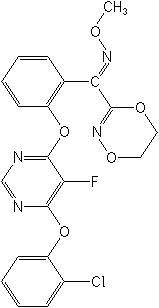-
Common NameFluoxastrobin
-
中文通用名氟嘧菌酯
-
IUPAC(E)-{2-[6-(2-chlorophenoxy)-5-fluoropyrimidin-4-yloxy]phenyl}(5,6-dihydro-1,4,2-dioxazin-3-yl)methanone O-methyloxime
-
CAS(1E)-[2-[[6-(2-chlorophenoxy)-5-fluoro-4-pyrimidinyl]oxy]phenyl](5,6-dihydro-1,4,2-dioxazin-3-yl)methanone O-methyloxime
-
CAS No.361377-29-9
-
Molecular FormulaC21H16ClFN4O5
-
Molecular Structure
-
Category
-
ActivityFungicide
HEC 5725 acts by inhibiting electron transport between cytochrome b and c1 in the mitochondrial respiratory chain. It provides both protective and curative activity, affecting both the early phases of the fungal infection process (spore germination, germ tube growth and leaf penetration) and mycelial growth. Due to its excellent leaf systemicity, HEC 5725 is rapidly taken up into the wax layer of the leaf and is distributed evenly by acropetal transport in the leaf. However, tests with radio-labelled compound show that uptake via seeds and roots is lower (BCPC, 2002).
HEC 5725 shows a broad spectrum of activity against Ascomycete, Basidiomycete, Deuteromycete and Oomycete fungi. When used as a seed treatment at 5-10 g ai / 100 kg seed, it provides broad spectrum control and long-lasting protection from seed and soil-borne pathogens such as snow mould (Monographella nivalis) and bunt (Tilletia caries), but not wind-borne diseases such as powdery mildew or net blotch of barley.
HEC 5725 provides complete control of Septoria leaf spot disease, including Septoria glume blotch, and good control of rust diseases (matching or exceeding the level of that of commercial products) in winter wheat.
The timing of application is quite flexible as HEC 5725 is rapidly taken up and translocated into the leaf. Control of Septoria triticiis provided both in the phases of growth early in the season and during the rapid growth of the canopy. The control of foliar wheat diseases is claimed to be superior to all other strobilurins, apart from pyraclostrobin (D0084) against S tritici.
HEC 5725 provides efficient control of all important barley leaf diseases to the level of, or exceeding that of commercial products. Rhynchosporium secalis, which requires a fungicide with a strongly pronounced leaf systemicity, Pyrenophora teres, Puccinia hordei and Blumeria graminis f. sp. hordeiare all well controlled.
Field trials in cotton in Brazil in 2000/2001 showed that a mixture of fluoxastrobin and tebuconazole was effective in controlling ramulose (Colletotrichum gossypiivar. cephalosporioides), though less potent than azoxystrobin, trifloxystrobin, trifloxystrobin + propiconazole or trifloxystrobin + tebuconazole.
HEC 5725 will either be developed as co-formulations or recommended as a tank mix with fungicides from other chemical classes, thus broadening the spectrum of activity, in particular, in wheat. From the results of field trials (BCPC 2002), prothioconazole (D0117) is suggested as a good partner for HEC 5725 as it will provide: i) activity towards stem base and ear diseases, for example, Pseudocercosporella herpotrichoides and Fusarium ear blight, and ii) additive effects.
The combination with prothioconazole was evaluated as a seed treatment with metalaxyl in Canada in 2001 for the control of root rot (Rhizoctonia solani) and anthracnose (Colletotrichum lindemuthianum) on dry beans. The treatments resulted in a higher stand of plants and increased seed yield compared to the untreated control. Fluoxastrobin + prothioconazole, applied as a seed treatment, was also effective for the control of root rot on lentil, field pea, soybean and chickpea. -
CropUseCropUses:
alfalfa, barley, celery, cereals, coffee, cotton, ornamentals, peanuts, peppers, potatoes, tobacco, tomatoes, turf, vegetables, cardoon, Chinese celery, celtuces, Florence fennels, rhubarbs, Swiss chards, Arracacha, arrowroots, Chinese artichokes, cannas, cassava, chayotes, chufas, dasheens, ginger, lerens, sweet potatoes, taniers, turmeric, yams
Cereals
200 g/ha
Coffee
75 - 100 g/ha
Potatoes
100 - 200 g/ha
Vegetables
100 - 200 g/ha
-
Disease SpectrumAlternaria solani, net blotch, powdery mildew, Phytophthora infestans, Puccinia triticina, rust, Rhynchosporium secalis, Septoria nodorum, Septoria tritici.
-
FormulationSC = Suspension concentrate (=flowable concentrate)
-
PremixTebuconazole+fluoxastrobin
fluoxastrobin+tebuconazol
Fluoxastrobin+prothioconazole+trifloxystrobin
Fluoxastrobin+prothioconazole+tebuconazole
Fluoxastrobin+prothioconazole
Fluoxastrobin+myclobutanil
fluoxastrobin+flutriafol
Chlorothalonil+fluoxastrobin
-
Physical PropertiesWATER SOLUBILITY: 2.29 mg/l at 20° C (pH 7)
-
Toxicology
Acute oral (rat)
LD50 >2,500
-
Environmental Profile
Ecotoxicology:
Bobwhite quail: LD50>2,000 mg/kg ;Daphnia magna[48 h] : LC50>0.48 mg/L ;Rainbow trout [96 h] : LC50>0.44 mg/L ;Bees [contact] : LD50 >200 μg ai/bee ;Earthworm : LC50>1,000 mg/kg ;Bees [oral] : LD50 >843 μg ai/beeEnvironmental fate:
Fate in soil: DT50 16 - 119 days. -
Transport InformationHazard Class:O (Obsolete as pesticide, not classified)
Porduct NewsMore
Arysta presents Evito T Mix fungicide for wheat in Argentina
Bayer launches new fungicide seed treatment Scenic in Chile
Fluoxastrobin Prothioconazole Tebuconazole
Arysta releases third-generation strobilurin fungicide Evito in China
China first to grant fluoxastrobin technical registration
FMC introduces Fame fungicides
Arysta LifeScience’s fungicide Evito registered in Canada
Arysta/Cheminova received registration for fungicide Fortix
Related CompaniesMore
Jiangsu Good Harvest-Weien Agrochemical Co., Ltd.
Country: China
Glyphosate S-metolachlor Metaldehyde Metamitron Penoxsulam Florasulam Mesotrione Amicarbazone Pyraclostrobin Mesosulfuron-methyl

 0
0 Subscribe
Subscribe
